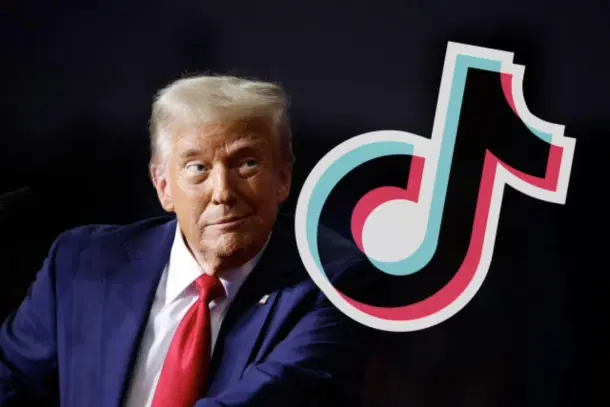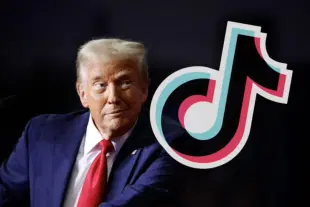Technology
When India Banned TikTok, It Took Days. So Why Is America Taking Years?
Deviyani G
Jan 23, 2025, 07:05 PM | Updated Oct 18, 2025, 10:53 PM IST
Save & read from anywhere!
Bookmark stories for easy access on any device or the Swarajya app.


The United States (US) Supreme Court (Scotus) in TikTok v Garland unanimously delivered a judgement upholding the federal court ban of the social media app TikTok.
While the US Congress has paused the law upholding the ban, its future remains uncertain.
The Joe Biden administration had refused to enforce the ban, with an official stating that it would have been unrealistic to expect the federal government to follow through in only a day's time.
Why was the app banned? Are the concerns around the app valid? Who stands to benefit the most from the ban? These are some questions that the trial has attempted to answer.
The Wrath Of Regulation
This is not the first time that TikTok has faced the wrath of regulation. India was the pioneer in severing ties with the Chinese app, following which several European Union (EU) nations and Australia have attempted to restrain the app’s use within their borders, primarily citing espionage concerns.
The crux of the issue lies with the ownership of the social media platform. TikTok is owned by the parent company ByteDance, a Beijing-based company, which, to quote the judgement, "is subject to Chinese laws that require it to ‘assist or cooperate’ with the Chinese Government’s ‘intelligence work’ and to ensure that the Chinese Government has ‘the power to access and control private data’ the company holds.”
While Washington has been rather blunt in targeting China, New Delhi adopted a more tactful approach- without naming the dragon, the Ministry of Information and Broadcasting merely stated that it would be banning 59 apps after receiving "many complaints from various sources" about apps that were "stealing and surreptitiously transmitting users' data in an unauthorised manner."
"The compilation of these data, its mining and profiling by elements hostile to national security and defence of India, which ultimately impinges upon the sovereignty and integrity of India, is a matter of very deep and immediate concern which requires emergency measures," the ministry said.
The question now arises as to why TikTok, which arguably was equally popular in India before its ban, was muted more swiftly and with greater ease by New Delhi while it has evolved into a hydra-headed monster in the States, having survived:
Executive orders from President Trump during his first tenure (banning American companies from any “transaction” with ByteDance and its subsidiaries, including TikTok and also requiring ByteDance divest itself of TikTok’s U.S. operations) - which were subsequently withdrawn by the Biden administration in 2021,
Upholding by the US Court of Appeals for of Biden’s ban via 'Protecting Americans from Foreign Adversary Controlled Applications Act,’ and
Now even the SCOTUS' recent judgement validating the verdict of the Court of Appeals.
The Question of Freedoms
At the heart of the arguments presented at the US apex court are the rights that are guaranteed to American citizens under the first amendment.
A comparable provision within the Indian Constitution would be Article 19 (1), which makes freedom of speech and expression a fundamental right.
TikTok on its end argued that, by specifically singling it out, the American state was also violating its fifth-amendment equal protection rights (comparable to Article 14 in the Indian Constitution).
This argument was made as the ban specifically requires ByteDance to sell control over TikTok’s operations in the US, such that the President may determine that the app is “no longer being controlled by a foreign adversary” (which means China) or that there is no “operational relationship” between the new US platform and the “formerly affiliated entities” (such as ByteDance) that are controlled by China.
Organisations such as the ACLU (American Civil Liberties Union) and the Electronic Frontier Foundation (EFF), had filed an amicus brief when the case was initially heard at at the court of appeals, they argued
"To ban an entire communications platform used by tens of millions of Americans, the government must meet an extraordinarily high bar: It must show that the ban is the only way to prevent serious, imminent harm to national security, and that the ban limits no more speech than necessary to accomplish that purpose."
They also said the government’s invocation of “national security” does not lessen its burden under the First Amendment. To the contrary, they said- history has shown that courts must be vigilant in the face of broad claims that national security requires trampling on Americans constitutional rights.
These arguments were strengthened by the existence of the legal test, termed as “strict scrutiny.” This test is usually applied only to law that tends to regulate free speech by targeting the content of messages. Other laws that don't interfere with the content itself are generally subject to lesser scrutiny.
The US Supreme Court in its judgement stated that the TikTok ban is “facially content neutral” and is not subject to strict scrutiny. It instead went on to establish that the risk of China using TikTok to spy on Americans is so great that it dwarfs any free speech concerns that arise out of this law. It based its conclusion on a Congressional report that stated:
“TikTok’s ‘data collection practices extend to age, phone number, precise location, internet address, device used, phone contacts, social network connections, the content of private messages sent through the application, and videos watched.”
“Congress has determined that divestiture is necessary to address its well-supported national security concerns regarding TikTok’s data collection practices and relationship with a foreign adversary,” the court wrote.
Ironically even the lawyers defending TikTok don’t dispute the privacy concerns. This was acknowledged in the judgement as thus-
“TikTok does not dispute that the government has an important and well-grounded interest in preventing China from collecting the personal data of tens of millions of US TikTok users. Nor could they. The platform collects extensive personal information from and about its users.”
How India's Case Was Different
What helped in the Indian context were two things. First, our Constitution itself recognises that our fundamental rights are not absolute but qualified.
While Article 19(1), guarantees freedom of speech and expression (a right not guaranteed to non-citizens). It is followed by Article 19(2) which expressly enables the state to make laws that impose reasonable restrictions on such freedoms on the basis of- the sovereignty and integrity of India, the security of the state and friendly relations with foreign states.
An extension of this can be found in Section 69A of the IT Act, 2000, which empowers the government to block information from public access under the same specific conditions as those mentioned under Article 19(2).
The question of constitutionality of this section had already been answered in way back in 2015, in the case of Shreya Singhal V UoI.
Therefore, unlike in the states, India did not enact a special law but simply relied on existing provisions for the basis of the ban.
"...in view of the emergent nature of threats the ministry has decided to block 59 apps since in view of information available, they are engaged in activities which is prejudicial to sovereignty and integrity of India, defence of India, security of state and public order," New Delhi said.
Second was the timing of the ban: TikTok and other Chinese-owned apps were seen as agents of the same dragon that caused the martyrdom of 20 Indian soldiers during the Galwan clashes at the Line of Control (LoC).
Sharing a land border with China and witnessing tangible impacts of its interference helped create an atmosphere that justified the government’s action. A task much harder to achieve in a continent that has no shared geography with the dragon and where the app has evolved itself to become an intergal part of the average American's online experience.
Trump’s FlipFlops
Following his inaugural address, Trump issued an executive order suspending the TikTok ban for 75 days. With this strategic pause, the next decisive steps in addressing TikTok's data privacy concerns now rest squarely with the administration.
The path ahead for the app remains uncertain. Trump could push for disinvestment. He might also require the company to give up 50 per cent stake to avert a shutdown. He has suggested that tariffs on Chinese goods could hinge on whether Beijing approves a potential future deal.
This while TikTok repeatedly insists that China would bar the export of ByteDance’s algorithm.
Beijing had this to say, when asked about President Trump’s vision for Tik Tok-
“operation and acquisition of companies should be decided by companies and in line with Chinese law“
The US should “earnestly listen to the voice of reason” and “provide an open, fair, just and non-discriminatory business environment” for companies from all countries, China’s foreign ministry spokesperson Guo Jiakun said.
Either by way of disinvestment or shutdown, American companies stand to gain big. Kotick, McMillon, Rumble, and Microsoft all seem interested in owning stake, while Meta and Youtube are likely to witness a migration from TikTok, as already seen during the brief period the ban was in force.
No Indian company was able to similarly compete or capitalise upon the 2020 ban on TikTok, and Instagram reels have largely dominated the market ever since.
More recently however, Trump himself seems to have downplayed the Chinese threat. During his first interview after returning to the White House, he had this to say regarding security concerns related to the TikTok app-
"You can say that about everything made in China."
"We have so many things made in China. So why don't they mention that? The interesting thing with TikTok though is you're dealing with a lot of young people. Is it that important for China to be spying on young people? Young people watching crazy videos and things," he added.
Trump's initial framing of TikTok as a national security threat gave way to more nuanced remarks, revealing the intricate and often ambiguous nature of US-China technological tensions. His evolving stance highlights the complexity of distinguishing between genuine strategic risks and potential geopolitical posturing.
The TikTok controversy transcends a single app, representing a broader geopolitical chess match where technology becomes a proxy for international tensions. It illuminates the delicate balance between protecting national security and preserving digital freedoms, with global technological ecosystems increasingly becoming battlegrounds for strategic influence.
As governments worldwide reassess their stance on Chinese technology platforms, TikTok's uncertain future symbolises a pivotal moment in digital diplomacy. The ultimate resolution will likely set precedents for how nations navigate the intricate intersection of technological innovation, data privacy, and geopolitical strategy.




